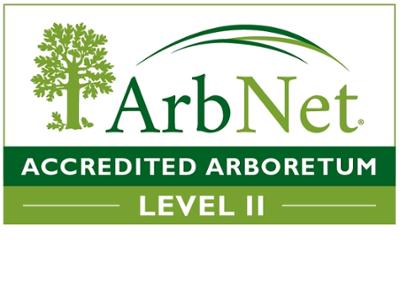

Hamilton’s arboretum is also recognized as an accredited arboretum in the Morton Register of Arboreta, a database of the world’s arboreta and gardens dedicated to woody plants. A Level II arboretum must feature at least 100 species of woody plants, employ a paid staff, and maintain enhanced public education programs and a documented collection policy.
With 787 trees, 114 shrubs, and perennials that are labeled on 1,350 acres, Hamilton’s arboretum includes 125 tree species. Plants are identified with plaques that list scientific and common names. All trees are tagged with a tree number tag and have been located and inventoried using GIS data. Of special note within the arboretum is the Grant Garden, home to the Saunders peonies. Professor A.P. Saunders hybridized tree peonies resulting in 80 named varieties.
ArbNet is an interactive, collaborative, international community of arboreta. It facilitates the sharing of knowledge, experience, and other resources to help arboreta meet their institutional goals and works to raise professional standards through the ArbNet Arboretum Accreditation Program.
The mission of the Hamilton Arboretum is to preserve the historic campus landscape, to build upon the diversity of the collection with sustainable species, and to reinforce the aesthetic character of the campus. It seeks to provide visitors with a broader understanding of the campus landscape and promote long-term stewardship of the environment. Goals of the arboretum are to:
- Provide an aesthetically pleasing, diverse, and accessible landscape conducive to academic study, recreation, meditation, and visitor interest
- Identify future planting goals through landscape guidelines that visually and spatially reinforce the character of both artificial and natural environments on campus
- Develop the arboretum as an outdoor laboratory to provide opportunities for botany, biology, and horticulture
- Preserve unique natural plant specimens of historic value
- Incorporate future plantings that are sustainable in Central New York, with an emphasis on native species
- Provide interpretive materials such as plant identification signs, maps, and accession records
- Provide opportunities for partnerships with local plant organizations
Activities include preserving and protecting existing the historic tree inventory, establishing collections, and providing a resource for education and enjoyment. The arboretum also offers public outreach with a free, public speaker series and tours, and aids research by College students, faculty, and staff.

Care and management of the arboretum is provided by a natural resources program manager, who is an International Society of Arboriculture-certified arborist. Other groundskeeping staff are responsible for caring for and maintaining the arboretum.
Posted August 21, 2020


